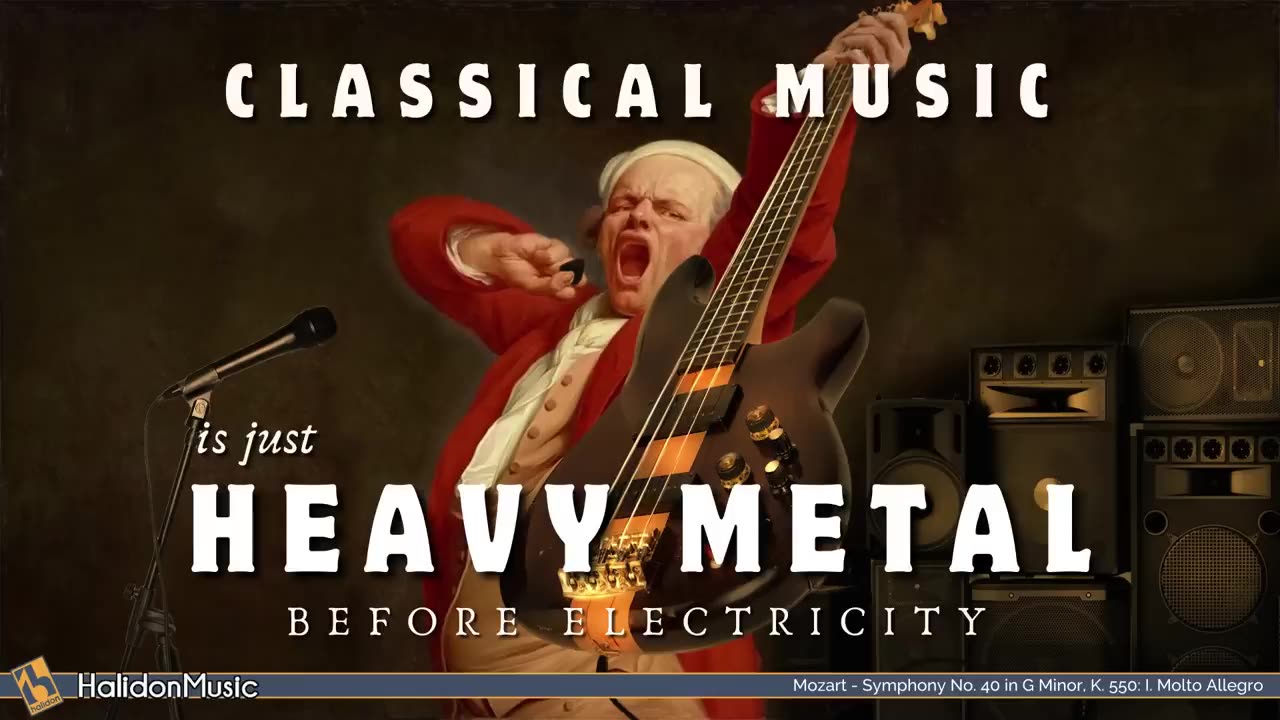Premium Only Content

Yes Or No? Classical Music Is Just Heavy Metal Before Electricity?
Apr 24, 2022 : Camille Borrelly 7 min read
At first glance, the world of classical music seems very different than the one of metal music. Indeed, how to find any point of agreement between the beautiful melodies carried by a symphonic orchestra within an auditorium or at the court of ancient kings, and the saturated riffs played by amplified instruments that reverberate in concert halls open to everyone? There might actually be more than just one reason to connect classical to metal music.
Like any other musical style, classical music and metal can be divided into many subgenres and varieties. Generally speaking, the expression ‘classical music’ encompasses the musical heritage carried by the so-called Western art music or formal music, namely Renaissance, Baroque, Classical, Romantic, Modern, and Contemporary music. In the late 1960s, metal started to become popular in the United Kingdom and the United States. It stems from Rock ’n’ Roll and is characterised by heavy, saturated sounds provided by amplified and distorted instruments. Each of these styles has its own musical codes, its own key players, and its own historical context. Music roots itself within society and reflects a facet of the contemporaries who listen to it or play it. So what do these two styles have in common?
Nowadays, classical music remains a major source of inspiration for metal and hard rock bands. The search for virtuosity and technique are not what keeps them apart. The lead guitarist of a band is anchored in his musical formation as a solo violinist would be in an orchestra. The search for virtuosity is felt in the famous Toccata and Fugue in D minor from Bach, which will later be used during their solos on stage by Van Halen and other forerunners of metal. Both classical music and metal music are very demanding and require their musicians to work several hours a day on their instruments or voices. And even if the rendering differs, it does not prevent the musicians from putting their heart into the shaping of their own technic.
The Swedish guitarist Yngwie Malmsteen driven by his virtuoso impulse initiated a whole new style of metal through his practice, a style later coined as neoclassical metal. He has often been considered as the caricature of the virtuoso who wanted to make his guitar sound like the great baroque instrumentalists, such as the violinist Niccolò Paganini whom he admired. He even composed a concerto Suite for Electric Guitar and Orchestra in E flat Minor which he performed with the New Tokyo philharmonic. Neoclassical metal, along with symphonic metal, is undoubtedly one kind of metal that connects to the classical heritage the most.
In symphonic metal, we often find classically trained singers who sing with a lyrical voice, like in opera. Either classical instruments and orchestras are used in the compositions (as it is the case in bands like Therion, Nightwish, Epica, etc.), or an amplified instrument (most often the guitar) is used to play melodies with classical influences. Many bands even use classical pieces as an introduction to their albums or in some of their songs. For instance, the search for the grandiose and the epic is as important for metal bands as it is in the Dies Irae of Verdi’s Requiem, Tchaikovsky’s 182 Overture, Dvorak’s New World Symphony, Beethoven’s symphonies, Edward Grieg’s In the Hall of the Mountain King, etc. It is not without reminding us of epic poems and sagas, mythologies, fantasy worlds, or chivalrous novels that create a valuable source of inspiration common to both musical genres. Many metal fans and musicians, for example, share a passion for Norse mythology and the Viking heritage with Wagner.
Figure 4: Illustration by Josef Hoffman on the series of four operas ‘Der Ring des Nibelungen’ from Wagner.
Figure 5: Illustration for the album ‘By the light of the northern star’ released in 2009, by the band Tyr.
Purely technical elements remain common to both styles of music. For example, the tritone interval was said to be forbidden in liturgical music, formerly widespread in the West. The latter favoured a harmony based on simple frequency ratios and the tritone, a specific interval, was considered too complex to play and was avoided by composers. The coup de grace came in the 18th century when Johann Fux, a famous composer and music theorist, called it ‘Diabolus in musica’ (the devil in music) in his harmony treatise ‘Gradus Ad Parnassum’ (J. Fux, 1965).
"Mi against fa is the devil in musica. This mi against fa you have written in the progression from the sixth to the seventh bar, by a skip of an augmented fourth or tritone, which is hard to sing and sounds bad, for which reason, is forbidden in strict counterpoint." (J. Fux, 1971, p. 35)
And since this treatise on harmony influenced whole generations of composers, the tritone was even more avoided. But the composers of the romantic period of the 19th century brought this interval back into fashion. Romantic music aimed at emancipating from the classical heritage, which was more focused on rationalism, whereas romantic composers privileged emotions and feelings. They experimented more to incorporate new sounds and the tritone proved to be ideal to express anger or frustration.
Figure 6: The tritone in music theory corresponds to an interval between two notes which is disturbing to the ears. It corresponds to an augmented fourth or diminished fifth.
This is probably one of the reasons why Berlioz used it in his piece La Damnation de Faust, Liszt in his work Après une Lecture du Dante: Fantasia quasi Sonata, and Tartini in his famous sonata ‘Il trillo del diavolo’. Furthermore, to reinforce the myth, Tartini confessed that the melody of his sonata had come to him in a dream when he heard the devil himself take hold of his violin to draw extraordinary notes from it.
Figure 7: The dream of Tartini , illustration by Louis-Léopold Boilly, 1824.
The interval keeps its reputation and will be used in songs like The Inner Light and Within You Without You by the Beatles, or in Red of King Crimson. But it is undoubtedly in 1970 with the song Black Sabbath of the eponymous band, that the tritone resounded in the ears of the whole world. Later, the band was considered one of the precursors of heavy metal and influenced countless musicians around the world such as Metallica, Slayer, Marilyn Manson, or Slipknot. All of them used tritone in their music, making it an inseparable element of the genre. In homage to the tritone, Slayer even named one of their records Diabolus in Musica. And since heavy metal is a musical trend closely associated with death, the devil and the tritone meet once again.
Figure 8: Slayer’s ‘Diabolus in Music
Low frequencies are also favoured in the composition of metal songs. The electric bass plays an increasingly important role in today’s bands. This is reminiscent of Beethoven’s method of composing, who, as he grew older, became almost deaf. He thus soon fell into some kind of madness, being separated from his peers. He started then to compose more in the lower register, with heavy chords, in order to hear better. Indeed, low frequencies are more easily perceptible by the ear.
Figure 9: Ludwig Van Beethoven, German composer
The public's opinion upon listening to these new sounds and musical structures is far from being unanimous. Classical music, just like metal today, was far from being popular for everyone. The more composers experimented, the more they were confronted with harsh feedback from their audience. Jean-Philippe Rameau is one of them. Madame la Marquise shares her own opinion in letters she wrote as a criticism for his operas, published by the abbot Mably in 1741.
’I hate them, it’s an awful racket, it’s only noise, it makes one dizzy’. When you don’t like Rameau, you criticize him using the same arguments that we mentioned earlier, when we analysed the polemics against excess: too many notes, too much noise, too many oddities, lack of simplicity, and naturalness.’ (P. Saby, Notes autour de l'idée de classicisme en France au milieu du dix-huitième siècle, 2001)
It is quite similar to the opinion carried by today’s non-metal fans that take offense on the news when a festival or concert of metal resounds in their neighbourhood.
Figure 10: Lettres à Madame la Marquise de P. sur l’Opéra — Abbot Mably
In many ways, classical music and metal music are interconnected. It is unexpected, and virtuosity and as well as technicality prevail in the way each composition is built. Common sources of inspiration also bring them together: Norse mythology, history, a certain passion and will to express deep emotions, etc. Both classical music and metal music respond to their own codes and have not always been well perceived by their contemporaries. Innovation and experimentation do not please everyone, but they enrich music itself.
Like a language that draws its terms, syntax, and so on from different dialects and other tongues, musical genres evolve in times thanks to the source of inspiration perpetrated by countless composers and musicians that pioneered new cultural movements. Often associated with a sense of madness, as a mad scientist in his laboratory, metal musicians contribute in their own way to a new musical landscape for our future, as did their ancestors.
References:
BÉRNARD, N. (2017). Homo Metallicus (English Edition). CAMION BLANC.
SCOTT, N. W. R. & VON HELDEN I. (2010). The Metal Void: First Gatherings. Oxford, Interdisciplinary Press.
TOLVANEN H. The quiet past and the loud present: the Kalevala and heavy metal. Open Edition Journals.
LEVEILLÉ A. & PERRIER B. (2018). La musique classique et le métal, des univers musicaux pas si éloignés. RTS, Culture.
ABROMONT C. & MONTALEMBERT E. D. (2001). Guide de la théorie de la musique. FAYARD.
Image references:
Figure 1: picture of Van Halen (1978), photography poster by BUGUAN ART, retrieved from Amazon’s website.
Figure 2: portrait of Niccolò Paganini, lithography, unknown artist, now belongs to the public domain, from the B.N.F. (French National Library)
Figure 3: portrait of Yingwie Malmsteen, unknown photographer, retrieved from https://www.allformusic.fr/yngwie-malmsteen
Figure 4: Hundings-Saal (1876), oil sketch, Josef Hoffman, https://fr.wikipedia.org/wiki/L%27Anneau_du_Nibelung
Figure 5: cover of the album By the light of the northern star by Tyr, digital drawing, artwork by Gyula Havancsak (2009),
https://en.wikipedia.org/wiki/By_the_Light_of_the_Northern_Star
Figure 6: explanatory musical staff retrieved from https://www.learnguitarmalta.com/tritone-lesson-consonance-dissonance/, article by Robert Callus (2022)
Figure 7: lithography by Louis Léopold Boilly (18th century), retrieved from https://www.mediathequeouestprovence.fr/cms/articleview/id_profil/423/id/7771
Figure 8: cover of the album Diabolus in musica by Slayer, photography by Exum (1988), retrieved from https://www.metalzone.fr/slayer/diabolus-in-musica/
Figure 9: portrait of Ludwig Van Beethoven (1820), painting (oil on canvas) by Josef Karl Stieler, photo by Universal History Archive/Gerry images, retrieved from https://www.radiofrance.fr/francemusique/podcasts/le-van-beethoven/une-heure-un-compositeur-ludwig-van-beethoven-4638086
Figure 10: Lettres à Madame La Marquise de P. sur l’Opéra, Chez Didot, 1741 (scanned in 2012), original copy at the public library of Lyon in France, retrieved from https://books.google.fr/books?id=MesoP324_-oC&pg=PR3&hl=fr&source=gbs_selected_pages&cad=2#v=onepage&q&f=false
https://www.byarcadia.org/post/from-classical-music-to-heavy-metal#:~:text=Nowadays%2C%20classical%20music%20remains%20a,would%20be%20in%20an%20orchestra.
-
 1:42:05
1:42:05
JUST A HOMELESS MAN
3 months agoThe Floor Jansen Tea Time Interview You ALL Have Been Waiting For!!!!
1041 -
 9:49
9:49
Tundra Tactical
2 hours ago $0.41 earnedThe Best Tundra Clips from 2024 Part 1.
2.57K1 -
 1:05:19
1:05:19
Sarah Westall
3 hours agoDying to Be Thin: Ozempic & Obesity, Shedding Massive Weight Safely Using GLP-1 Receptors, Dr. Kazer
3.16K3 -
 DVR
DVR
LFA TV
1 day agoThe Resistance Is Gone | Trumpet Daily 12.26.24 7PM EST
4.98K2 -
 DVR
DVR
theDaily302
11 hours agoThe Daily 302- Tim Ballard
6.01K1 -
 13:22
13:22
Stephen Gardner
5 hours ago🔥You'll NEVER Believe what Trump wants NOW!!
60.8K164 -
 54:56
54:56
Digital Social Hour
1 day ago $7.51 earnedDOGE, Deep State, Drones & Charlie Kirk | Donald Trump Jr.
29.2K2 -
 DVR
DVR
The Trish Regan Show
7 hours agoTrump‘s FCC Targets Disney CEO Bob Iger Over ABC News Alleged Misconduct
37.5K34 -
 1:48:19
1:48:19
The Quartering
7 hours agoElon Calls White People Dumb, Vivek Calls American's Lazy & Why Modern Christmas Movies Suck!
120K98 -
 2:08:42
2:08:42
The Dilley Show
8 hours ago $32.37 earnedH1B Visa Debate, Culture and More! w/Author Brenden Dilley 12/26/2024
108K24